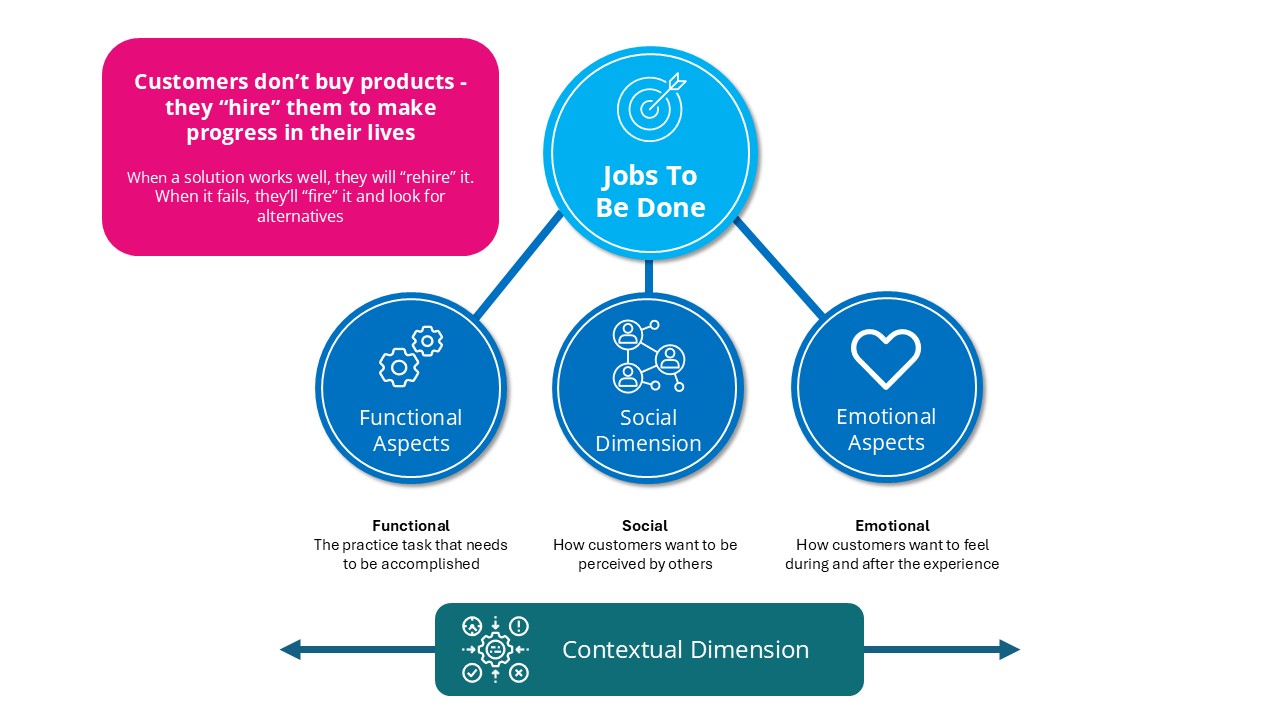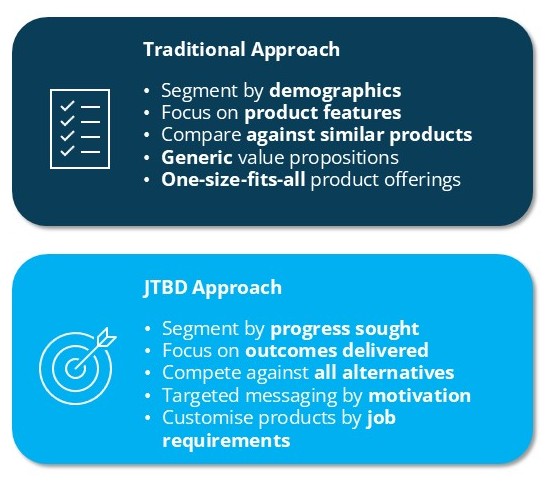Author: Nick Rassool | Posted On: 15 Jul 2025
In competitive markets, understanding why customers choose certain products over others is critical for driving growth. Jobs to be Done (JTBD) is a practical framework that Fifth Quadrant uses to uncover what customers are really trying to achieve, delivering actionable insights that drive immediate business results.
What is Jobs To Be Done?
Developed by Harvard Business School’s Clayton Christensen and innovation consultant Bob Moesta, JTBD suggests that people don’t simply buy products: they “hire” them to make progress in their lives. Christensen’s famous milkshake study revealed that morning commuters were hiring milkshakes not for taste, but as a convenient, filling breakfast that could be consumed one-handed during their drive without making their hands greasy on the steering wheel, a problem that traditional breakfast foods couldn’t solve.
At JTBD’s core is the “struggling moment”, when someone realises their current solutions don’t work for their specific constraints and context. This moment triggers the desire to make progress, leading them to consider new options. JTBD helps businesses understand the causality behind customer switching behaviour.
Understanding the complete job
JTBD reveals that every customer decision involves four interconnected components: contextual (the trigger situation), functional (the practical task), emotional (how they want to feel), and social (how they want to be perceived by others).
Take Uber as an example. When someone finishes a long meeting feeling drained, they’re not just solving a transport problem. The functional job involves getting home quickly, but the emotional component centres on feeling safe and avoiding hassle. The social dimension relates to appearing competent and self-sufficient, someone who knows how to get things done efficiently without relying on outdated or inconvenient services. The contextual trigger is the specific situation: evening, fatigue, and wanting instant control over their journey home.
Uber’s success lies in curating a solution for all these elements simultaneously, not just providing transport. Features like real-time tracking, upfront pricing, and driver ratings address emotional anxieties, whilst the seamless app experience reinforces the social job of appearing tech-savvy and in control.

Stop competing against luck
Most businesses compete against the wrong rivals. Traditional market research analyses competitors by focusing on similar products, but JTBD reveals the true competitive landscape through three distinct categories:
- Direct competitors do the same job in the same way; other similar products or services targeting identical outcomes through identical methods.
- Secondary competitors address the same job but through completely different approaches, timelines, and value propositions. These often represent the largest competitive threat.
- Indirect competitors solve different jobs with conflicting outcomes, including the powerful force of non-consumption; customers choosing to do nothing rather than switch.
Consider Uber’s true competitive landscape. Uber isn’t just competing against other ride-hailing apps (direct competitors). The real competition includes traditional taxis, public transport, walking, or asking colleagues for lifts (secondary competitors), plus staying late at the office until transport improves, booking a nearby hotel, or avoiding late meetings altogether (indirect competitors).
A recent Fifth Quadrant case study in Australia’s agricultural sector illustrates this perfectly. Whilst the client, a provider of modular housing, focused initially on competing against other similar companies, our JTBD research revealed that farmers primarily use repurposed mining dongas, converted pubs, and off farm rental solutions. The real competition wasn’t other modular providers, it was convincing farmers to abandon familiar alternatives.

The four forces framework
JTBD identifies four psychological forces influencing every switching decision:
- Push forces create dissatisfaction with current solutions: pain points, frustrations, or limitations that motivate change.
- Pull forces represent the appeal of better outcomes: the promise of improved performance, efficiency, or experience.
- Anxiety forces generate concerns about switching: fears about unknown risks, implementation challenges, or potential regret.
- Habit forces maintain attachment to familiar solutions: comfort with existing processes, relationships, or investments.
Successful products amplify push and pull whilst reducing anxiety and breaking ingrained habits. Understanding these forces helps businesses design offerings and messaging that encourage switching behaviour.
JTBD in B2B environments
Business-to-business applications of JTBD require understanding the complex stakeholder dynamics behind organisational decisions. Unlike consumer purchases, B2B decisions often involve multiple people with different objectives, constraints, and success criteria.
The key is identifying who influences the decision, who holds it back, and who drives it forward, along with their respective motivations. This might require several rounds of interviews to map the complete decision-making ecosystem and understand how different stakeholders frame trade-offs.
When JTBD has limitations
JTBD works best when customers have genuine choice and agency in their decisions. It’s less effective in monopolistic situations where alternatives don’t exist, or in purely compliance-driven contexts where regulatory requirements dictate solutions regardless of customer preference.
From insights to action
JTBD research delivers immediate strategic insights that transform business decisions. It reveals market segments based on progress sought rather than demographics, identifies underserved jobs that competitors miss, and explains why prospects stall in your sales funnel.
Unlike personas that describe who customers are, JTBD explains why they act, and transforms insights into specific business decisions across four critical areas:
- Product development becomes laser-focused. Instead of building features customers request, teams build capabilities that help customers make progress.
- Marketing messaging targets motivations, not demographics. Rather than advertising to a segment, messaging speaks to specific struggling moments.
- Sales strategy anticipates objections and triggers. Understanding anxiety forces helps sales teams address concerns proactively, whilst knowing habit forces reveals why prospects delay decisions. Sales conversations shift from product features to progress outcomes.
- Competitive positioning expands beyond obvious rivals. Businesses stop fighting feature wars with direct competitors and start addressing why customers choose alternative approaches or delay action entirely.
Ultimately, JTBD transforms the “so what ” into “must do” strategy, converting customer insights into competitive advantage through practical, implementable actions.
Ready to uncover what truly drives your customers’ decisions? Discover how Fifth Quadrant’s Jobs to Be Done research reveals hidden opportunities, reshapes your competitive landscape, and delivers actionable insights that drive growth. Contact us today.
Posted in B2B, Consumer & Retail, Social & Government, TL, Uncategorized

